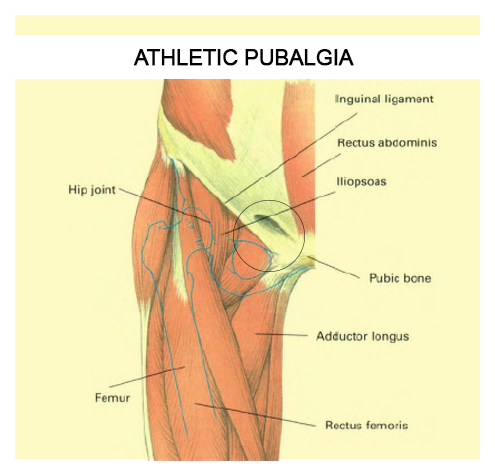Athletic pubalgia is often referred to as a sports hernia, groin disruption or Gilmore’s groin, it is a common groin injury experienced by athletes. It was first recognized as “Gilmore’s groin” in 1980, following the groin repair treatment of some professional soccer players who were unable to participate in their sport for a few months because of an undiagnosed groin injury. Jerry Gilmore developed a surgical repair technique for this condition. Generally athletic pubalgia (Gilmore’s groin or sports hernia) is located more laterally (on the side) and proximally (nearest to the midline and point of attachment) and a groin disruption includes more of a range of abnormalities. However, they are very similar conditions and difficult to differentiate, therefore they tend to be treated in the same way. For our purpose we will look at these injuries as one condition.
Athletic pubalgia involves severe musculotendinous injuries (relate to muscles and tendons) that result in chronic groin pain and a dilated superficial inguinal ring. Generally a tear in one of your lower abdominal muscles (oblique muscles, rectus abdominus muscle) near the back wall of your inguinal canal (narrow passage through your abdominal wall in the lower region on either side of your pubic area), or in your connective tissues (conjoined tendon, inguinal ligament, transversalis fascia, or aponeurosis) where your muscles meet the bones and other tissues of your pelvis and/or pubic bone will be present. Athletic pubalgia results in a “hidden” hernia that has no visible bumps or lumps but causes pain in your lower abdomen and groin (especially when twisting or turning while running at a high speed). Often you will experience a torn adductor muscle along with this injury.
Note: An inguinal hernia involves a tear in a body tissue (normally a muscle) that shows a visible bulge or bump in your lower abdomen. Athletic pubalgia has no obvious hernia (bump or bulge).
